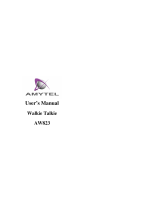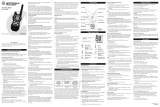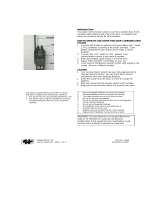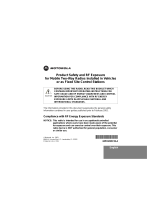Page is loading ...

010730-O
Models T7100 and T7200
A
@6864110R94@
6864110R94-O
6881038B85.book Page 0 Thursday, August 30, 2001 3:07 PM

6881038B85.book Page 1 Thursday, August 30, 2001 3:07 PM

Introduction
Thank you for purchasing a Motorola T7000-Series radio. Your radio is a product of
Motorola’s 70 years of experience as a world leader in the designing and
manufacturing of communications equipment. This revised industrial design reflects
the heritage and ruggedness of the Talkabout Series line. With proper care and use,
your Motorola radio should give you years of reliable communication.
Motorola two-way radios are the perfect communications solution for all of today’s
fast-paced industries.
Note: Please read this manual carefully to ensure you know how to properly
operate the radio before use.
Product Specifications
Frequency UHF (MHz) 462.5625-467.7250
Channels
22
30
T7100
T7200
Codes 38 X CTCSS
Channel Spacing 12.5/25kHz Consumer selectable
Power Source
1 NiMH Battery
4 AA Alkaline or off the shelf nickel
rechargeable batteries
6881038B85.book Page 2 Thursday, August 30, 2001 3:07 PM

Literature (Not shown)
Motorola, the Stylized M Logo, and all other trademarks indicated as such herein are
trademarks of Motorola, Inc.
Reg. U.S. Pat. & Tm. Off.
© 2001 Motorola, Inc. All rights reserved. Printed in the U.S.A.
Motorola
Consumer Products Division
1705 Belle Meade Court
Lawrenceville, GA 30043
For a copy of a large-print version of this guide, or for product-related
questions, please call the following numbers:
1-800-353-2729 (U.S.A.) 1-800-461-4575 (Canada)
1-888-390-6456 TTY (Text Telephone)
1-888-390-6456 TTY (Text Telephone)
On the web, please refer to the following url:
www.motorola.com/talkabout
6881038B85.book Page 3 Thursday, August 30, 2001 3:07 PM

Contents
PRELIMINARY
4
Contents
FCC Licensing Information . . . . . . . 1
Getting Started . . . . . . . . . . . . . . . . . 3
Turning On/Off Your Radio . . . . . . . 3
Diagram of Your Radio’s Display . . 4
Installing Batteries . . . . . . . . . . . . . . 5
Charging . . . . . . . . . . . . . . . . . . . . . 8
Before Using Your Radio . . . . . . . . 10
Diagram of Radio and its Functions 11
Operating Your Radio . . . . . . . . . . 12
Talking Range . . . . . . . . . . . . . . . . 12
Changing Your Radio’s Settings
through Button Combinations . . . 13
Accessing the Backlight . . . . . . . . 14
Checking Monitor/
Signal Strength Indicator . . . . . . 14
Talk Confirmation Tone . . . . . . . . . 15
Button Beeps . . . . . . . . . . . . . . . . . 15
Changing Radio’s Menu Settings . 16
Setting the
Channel . . . . . . . . . . . . . . . . . . . 16
Interference Eliminator Code . . . 16
Call Tone and Call Display . . . . . 17
Sensitivity Level . . . . . . . . . . . . . 18
Preferences for Scanning List . . 20
Battery *Type . . . . . . . . . . . . . . . 22
Table of Menu Functions . . . . . . . . 22
Advanced Features (T7100/T7200) 25
Selecting Bandwidth . . . . . . . . . . . 25
Advanced Features (T7200 Only) . 26
Setting Eavesdrop Reducer . . . . . 26
Understanding Repeater Channels 27
Setting Repeater Channels . . . . 28
Setting Repeater Interference
Eliminator Codes . . . . . . . . . . 28
Scanning Repeater Channels . . 29
Weather . . . . . . . . . . . . . . . . . . . . . 29
Turning On Weather Channel
Reception . . . . . . . . . . . . . . . 30
Setting the Weather Channel . . 30
Using Accessories . . . . . . . . . . . . . 32
Use and Care . . . . . . . . . . . . . . . . . 35
Frequency and Code Charts . . . . . 36
Troubleshooting . . . . . . . . . . . . . . . 39
Motorola Limited Warranty . . . . . . 42
6881038B85.book Page 4 Thursday, August 30, 2001 3:07 PM

PRELIMINARY
5
6881038B85.book Page 5 Thursday, August 30, 2001 3:07 PM

Safety and General Information
i
PRELIMINARY
Safety and General Information
Important Information on Safe and Efficient Operation
Read This Information Before Using Your Radio
The information provided in this document supersedes the general safety
information contained in user guides published prior to July 2000. For information
regarding radio use in a hazardous atmosphere please refer to the Factory Mutual
(FM) Approval Manual Supplement or Instruction Card, which is included with radio
models that offer this capability.
RF Operational Characteristics
Your radio contains a transmitter and a receiver. When it is ON, it receives and
transmits radio frequency (RF) energy. The radio operates in the frequency range of
461 MHz to 497 MHz. The output power level typically may vary over a range from
0.5 watts to 1.0 watt.
Exposure to Radio Frequency Energy
Your Motorola radio is designed to comply with the following national and
international standards and guidelines regarding exposure of human beings to radio
frequency electromagnetic energy:
• United States Federal Communications Commission, Code of Federal
Regulations; 47 CFR part 2 sub-part J
• American National Standards Institute (ANSI) / Institute of Electrical and
Electronic Engineers (IEEE) C95. 1-1992
• Institute of Electrical and Electronic Engineers (IEEE) C95.1-1999 Edition
• National Council on Radiation Protection and Measurements (NCRP) of the
United States, Report 86, 1986
6881038B85.book Page i Thursday, August 30, 2001 3:07 PM

Safety and General Information
ii
PRELIMINARY
• International Commission on Non-Ionizing Radiation Protection (ICNIRP) 1998
• Ministry of Health (Canada) Safety Code 6. Limits of Human Exposure to Radio
Frequency Electromagnetic Fields in the Frequency Range from 3 kHz to 300
GHz, 1999
• Australian Communications Authority Radiocommunications (Electromagnetic
Radiation - Human Exposure) Standard 1999 (applicable to wireless phones
only)
To assure optimal radio performance and make sure human exposure to radio
frequency electromagnetic energy is within the guidelines set forth in the above
standards, always adhere to the following procedures:
Portable Radio Operation and EME Exposure
Antenna Care
Use only the supplied or an approved replacement antenna. Unauthorized
antennas, modifications, or attachments could damage the radio and may violate
FCC regulations.
DO NOT hold the antenna when the radio is “IN USE.” Holding the antenna
affects the effective range.
6881038B85.book Page ii Thursday, August 30, 2001 3:07 PM

Safety and General Information
iii
PRELIMINARY
Two-Way Radio Operation
When using your radio as a traditional two-way radio, hold the radio in a
vertical position with the microphone two to three inches (5. 0 to 7.5 cm)
away from the lips.
Body-Worn Operation
To maintain compliance with FCC/Health Canada RF exposure guidelines,
if you wear a radio on your body when transmitting, always place the radio
in a Motorola supplied or approved clip, holder, holster, case, or body
harness for this product. Use of non-Motorola-approved accessories
may exceed FCC RF exposure guidelines. If you do not use a body-
worn accessory, ensure the radio and its antenna is at least two inches
(5 cm) from your body when transmitting.
Data Operation
When using any data feature of a device, with or without an accessory cable,
position the device and its antenna at least one inch (2.5 cm) from the body.
Approved Accessories
For a list of approved Motorola accessories refer to the Two-Way Radio section of
www.motorola.com/store.
Electromagnetic Interference/Compatibility
Note: Nearly every electronic device is susceptible to electromagnetic interference
(EMI) if inadequately shielded, designed or otherwise configured for
electromagnetic compatibility.
6881038B85.book Page iii Thursday, August 30, 2001 3:07 PM

Safety and General Information
iv
PRELIMINARY
Facilities
To avoid electromagnetic interference and/or compatibility conflicts, turn off your
radio in any facility where posted notices instruct you to do so. Hospitals or health
care facilities may be using equipment that is sensitive to external RF energy.
Aircraft
When instructed to do so, turn off your radio when on board an aircraft. Any use of a
radio must be in accordance with applicable regulations per airline crew instructions.
Medical Devices
Pacemakers
The Advanced Medical Technology Association recommends that a minimum
separation of 6 inches (15 centimeters) be maintained between a handheld wireless
radio and a pacemaker. These recommendations are consistent with the
independent research by, and recommendations of the U.S. Food and Drug
Administration.
Persons with pacemakers should:
• ALWAYS keep the radio more than six inches (15 centimeters) from their
pacemaker when the radio is turned ON.
• not carry the radio in the breast pocket.
• use the ear opposite the pacemaker to minimize the potential for interference.
• turn the radio OFF immediately if you have any reason to suspect that
interference is taking place.
6881038B85.book Page iv Thursday, August 30, 2001 3:07 PM

Safety and General Information
v
PRELIMINARY
Hearing Aids
Some wireless radios may interfere with some hearing aids. In the event of such
interference, you may want to consult your hearing aid manufacturer to discuss
alternatives.
Other Medical Devices
If you use any other personal medical device, consult the manufacturer of your
device to determine if it is adequately shielded from RF energy. Your physician may
be able to assist you in obtaining this information.
Safety and General Use While Driving
Check the laws and regulations on the use of radios in the area where you drive.
Always obey them. When using your radio while driving, please:
• Give full attention to driving and to the road.
• Use hands-free operation, if available.
• Pull off the road and park before making or answering a call if driving conditions
so require.
Operational Warnings
For Vehicles with an Air Bag
Do not place a portable radio in the area over an air bag or in the air bag deployment
area. Air bags inflate with great force. If a portable radio is placed in the air bag
deployment area and the air bag inflates, the radio may be propelled with great force
and cause serious injury to occupants of the vehicle.
6881038B85.book Page v Thursday, August 30, 2001 3:07 PM

Safety and General Information
vi
PRELIMINARY
Potentially Explosive Atmospheres
Turn off your radio prior to entering any area with a potentially explosive
atmosphere, unless it is a radio type especially qualified for use in such areas as
“Intrinsically Safe.”
Do not remove, install, or charge batteries in such areas. Sparks in a potentially
explosive atmosphere can cause an explosion or fire resulting in bodily injury or
even death.
Note: The areas with potentially explosive atmospheres referred to above include
fueling areas such as below decks on boats, fuel or chemical transfer or
storage facilities, areas where the air contains chemicals or particles, such
as grain, dust or metal powders, and any other area where you would
normally be advised to turn off your vehicle engine. Areas with potentially
explosive atmospheres are often but not always posted.
Blasting Caps and Areas
To avoid possible interference with blasting operations, turn off your radio when you
are near electrical blasting caps, in a blasting area, or in areas posted: “Turn off two-
way radio.” Obey all signs and instructions.
Operational Cautions
Antennas
Do not use any portable radio that has a damaged antenna. If a damaged
antenna comes into contact with your skin, a minor burn can result.
6881038B85.book Page vi Thursday, August 30, 2001 3:07 PM

Safety and General Information
vii
PRELIMINARY
Batteries
All batteries can cause property damage and/or bodily injury such as burns if a
conductive material such as jewelry, keys, or beaded chains touch exposed
terminals. The conductive material may complete an electrical circuit (short circuit)
and become quite hot. Exercise care in handling any charged battery, particularly
when placing it inside a pocket, purse, or other container with metal objects.
Charging Safety Instructions
Before using the battery charger, read all instructions and cautionary markings on:
1. the battery
2. the battery charger, and
3. the radio using the battery.
Caution: To reduce the risk of injury, charge only the rechargeable batteries listed.
Other types of batteries may burst, causing personal injury and damage.
Save these Instructions
1. Do not expose the charger to rain or snow.
2. Do not operate the charger if it has received a sharp blow, or has been dropped
or damaged in any way.
3. Do not disassemble the charger if it has received a sharp blow, or has been
dropped or damaged in any way.
4. Never alter the AC cord or plug provided with the unit. If plug will not fit the out-
let, have proper outlet installed by a qualified electrician. An improper condition
can result in a risk of electric shock.
5. To reduce risk of damage to cord or plug, pull the plug rather than the cord when
disconnecting charger from AC receptacle.
6881038B85.book Page vii Thursday, August 30, 2001 3:07 PM

Safety and General Information
viii
PRELIMINARY
6. To reduce the risk of electric shock, unplug the charger from the outlet before
attempting any maintenance or cleaning.
7. Use of an attachment not recommended or sold by Motorola may result in a risk
of fire, electric shock, or personal injury.
8. Make sure that the cord is located so that it will not be stepped on, tripped over,
or subjected to damage or stress.
9. An extension cord should not be used unless absolutely necessary. Use of an
improper extension cord could result in a risk of fire and/or electric shock. If an
extension cord must be used, make sure:
• That the pins on the plug of the extension cord are the same number, size and
shape as those on the plug of the charger.
• That the extension cord is properly wired and in good electrical condition, and
• That the cord size is18 AWG for lengths up to 100 feet, and 16 AWG for lengths up
to 150 feet.
10. The supply cord of this charger cannot be replaced. If the cord is damaged, call
Motorola Product Services at:
1-800-353-2729 (U.S.A.) 1-800-461-4575 (Canada)
1-888-390-6456 TTY (Text Telephone) 1-888-390-6456 TTY (Text Telephone)
6881038B85.book Page viii Thursday, August 30, 2001 3:07 PM

1
PRELIMINARY
FCC Licensing Information
FCC
FCC Licensing Information
Your Motorola radio operates on General Mobile Radio Service (GMRS) frequencies
and is subject to the Rules and Regulations of the Federal Communications
Commission (FCC). The FCC requires that all operators using General Mobile Radio
Service (GMRS) frequencies obtain a radio license before operating their equipment.
To have the FCC forms please request Form 605
which includes all forms and
instructions. If you wish to have the document faxed, mailed or have questions,
please use the following contact information.
Before filling out your application, you must decide which frequency(ies) you can
operate on. See the Frequency and Code Charts found on page 36.
For questions on determining your radio frequency, please call Motorola Product
Services at:
1-800-448-6686
Faxed
contact the Fax-On-
Demand system at:
Mailed
call the FCC forms
hotline at:
Questions
regarding FCC license
contact the FCC at:
1-202-418-0177
1-800-418-FORM
1-800-418-3676
1-888-CALL-FCC
1-888-225-5322
Or: http://www.fcc.gov/Forms
6881038B85.book Page 1 Thursday, August 30, 2001 3:07 PM

FCC Licensing Information
2
PRELIMINARY
FCC
Changes or modifications not expressly approved by Motorola may void the user’s
authority granted by the FCC to operate this radio and should not be made. To
comply with FCC requirements, transmitter adjustments should be made only by or
under the supervision of a person certified as technically qualified to perform
transmitter maintenance and repairs in the private land mobile and fixed services as
certified by an organization representative of the user of those services.
Replacement of any transmitter component (crystal, semiconductor, etc.) not
authorized by the FCC equipment authorization for this radio could violate FCC rules.
Note: Use of this radio outside the country where it was intended to be distributed
is subject to government regulations and may be prohibited.
6881038B85.book Page 2 Thursday, August 30, 2001 3:07 PM

3
PRELIMINARY
Getting Started
Getting Started
Turning On/Off Your Radio
A Diagram of your New T7000 Series Radio and its Functions can be found on
page 8.
Note: The red indicator light underthe antenna flashes every three seconds.
Turn
knob
Display Normal Menu Mode
P
Turn knob on the top of the radio clockwise to use. Turn
the Knob counterclockwise to turn the radio off.
The radio chirps and the display will show all feature
icons that your radio has available for a period of
approximately three seconds.
Depending upon your radio model; T7100 will have
the channel 1-22 and the Interference Eliminator Code
(0-38)* left on display. *Previous usage dictates
Interference Eliminator Code.)
For T7200 the channel 1-22 and/or subsequent repeater
channel 15 x - 22 x will be left on display as in the
figure to the left.
x
6881038B85.book Page 3 Thursday, August 30, 2001 3:07 PM

Getting Started
4
PRELIMINARY
Diagram of Your Radio’s Display
Scan
Keypad Lock
Eavesdrop Reducer/Scramble
Signal Strength
Interference Eliminator Code
Weather T7200 only
VOX/Hands-free use with
or without accessories
Battery
Channel Indicator
1/2 Watt/Low Power
5
NORMAL USE ALL MODELS
Scan
Keypad Lock
Eavesdrop Reducer/Scramble
Signal Strength
(Frequency Indicators)
Weather T7200 only
VOX/Hands-free use with
or without accessories
Battery
Channel Indicator
1/2 Watt/Low Power
x
Repeater Channel
5
T7200 ONLY WITH REPEATER ENABLED
6881038B85.book Page 4 Thursday, August 30, 2001 3:07 PM

5
PRELIMINARY
Getting Started
Installing Batteries
Some radio packages include a rechargeable Nickel-Metal Hydride (NiMh) battery
(NTN8971), or you may use 4 AA alkaline batteries. If you would like to obtain the
battery, the charger or the Rechargeable Upgrade Kit (Accessory 53897), please call
the following numbers to locate the dealer nearest you:
(U.S.A.) 1-800-353-2729
(Canada) 1-800-461-4575
You may also obtain accessory items via Motorola’s Talkabout website:
www.motorola.com/talkabout
The NiMH Battery Installation
Your radio uses one rechargeable Nickel-Metal Hydride Battery (NTN8971). These
cells provide 13 hours* of radio use.
Note: *Based upon 5/5/90 duty cycle.
• To begin, push the Ribbed Latch on the
bottom of the radio away from the back cover,
or toward the contacts.
Ribbed
Latch
6881038B85.book Page 5 Thursday, August 30, 2001 3:07 PM

Getting Started
6
PRELIMINARY
AA Alkaline Batteries Installation
Your radio also uses 4 AA alkaline batteries; these
cells provide 20 hours* of radio use.
• Push the ribbed latch on the bottom of the
radio away from the battery door.
• Slide and lift the battery door off.
• Place AA batteries so that the + marking match
the markings in the compartment.
• Slide and snap the battery cover into place.
Note: Based upon 5/5/90 duty cycle.
• Slide and lift the back cover off.
• Place the battery (NTN8971) so that the
charge contacts are facing out toward the
battery door. The battery fits tightly into place.
• Slide and snap the cover back into place
6881038B85.book Page 6 Thursday, August 30, 2001 3:07 PM
/





